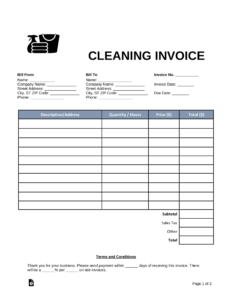Effective sales reporting is crucial for businesses of all sizes and industries. Sales reports provide valuable insights into the performance of your sales team, the effectiveness of your sales strategies, and the overall health of your business. However, creating sales reports from scratch can be time-consuming and challenging. That’s where sales report templates come in handy.
In this article, we will explore the importance of sales reports and how using a sales report template can streamline your reporting process. We will also provide you with a step-by-step guide on how to create and use a sales report template effectively. So, let’s dive in!
1. Importance of Sales Reports
Sales reports are essential tools that help businesses monitor and evaluate their sales performance. They provide valuable insights into various aspects of the sales process, helping sales managers and executives make informed decisions to improve sales strategies and drive revenue growth. Here are some key reasons why sales reports are important:
- Evaluating Sales Performance: Sales reports allow you to track and analyze the performance of your sales team, individual sales representatives, and territories. By comparing actual sales against targets, you can identify top performers, areas for improvement, and take corrective actions.
- Identifying Trends and Patterns: Sales reports help you identify trends and patterns in your sales data. By analyzing historical sales data, you can spot seasonal fluctuations, identify emerging trends, and adjust your sales strategies accordingly.
- Assessing Sales Funnel Efficiency: Sales reports enable you to assess the efficiency of your sales funnel by tracking key metrics such as lead-to-opportunity conversion rates, win rates, and average deal size. This helps you identify bottlenecks in your sales process and optimize it for better results.
- Monitoring Sales Goals: Sales reports allow you to monitor progress towards your sales goals. By regularly reviewing your sales reports, you can ensure that your team is on track and take proactive measures if you’re falling behind.
- Facilitating Data-Driven Decision Making: Sales reports provide data-driven insights that can guide your decision-making process. By analyzing sales data, you can identify opportunities, make informed sales forecasts, and allocate resources effectively.
2. The Role of Sales Report Templates
A sales report template is a pre-designed document that serves as a framework for creating sales reports. It provides a structured format for presenting sales data consistently and efficiently. Here’s how sales report templates can enhance your reporting process:
- Time-saving: Creating sales reports from scratch can be time-consuming, especially if you need to generate reports regularly. Sales report templates eliminate the need to start from scratch every time, allowing you to save time and focus on analyzing the data.
- Consistency: Sales report templates ensure consistency in reporting across your organization. By using the same template, you can present data consistently, making it easier to compare and analyze reports over time.
- Standardization: Sales report templates can help standardize the information included in your reports. You can define the key metrics, charts, and tables that should be included in every report, ensuring that all stakeholders receive the necessary information.
- Professionalism: A well-designed sales report template adds a professional touch to your reports. It shows that you have a structured approach to reporting and enhances the credibility of your data and analysis.
- Flexibility: Sales report templates can be customized to fit your specific reporting needs. You can add or remove sections, change the layout, and adapt the template to your unique requirements.
3. How to Create a Sales Report Template
Creating a sales report template involves a few key steps. By following these steps, you can create a comprehensive template that meets your reporting requirements:
Step 1: Define the Purpose of Your Sales Report
Before creating a sales report template, it’s important to clearly define the purpose of your report. Ask yourself what insights and information you want to convey through your reports. This will help you determine the key metrics, charts, and tables that should be included in your template.
For example, if your goal is to evaluate the performance of your sales team, you may want to include metrics such as total sales, sales by product or service, sales by territory, and individual sales representative performance.
Step 2: Choose the Right Reporting Software
Next, choose the right reporting software that suits your needs. There are various options available, ranging from spreadsheet software like Microsoft Excel to more advanced business intelligence tools like Tableau or Power BI. Consider the complexity of your reporting requirements, the volume of data you need to analyze, and your budget when selecting the software.
Using reporting software will make it easier to create, update, and analyze your sales reports. It also allows for automation and integration with other data sources, saving you time and effort.
Step 3: Determine the Key Metrics to Include
Identify the key metrics that you want to track and include in your sales report template. The metrics you choose will depend on the purpose of your report and the insights you want to gain. Here are some common metrics to consider:
- Total Sales: The total revenue generated from sales.
- Sales by Product/Service: The revenue generated from each product or service.
- Sales by Territory: The revenue generated from different sales territories or regions.
- Sales by Customer Segment: The revenue generated from different customer segments.
- Sales by Sales Representative: The individual sales performance of your team members.
- Conversion Rates: The percentage of leads that convert into opportunities or deals.
- Win Rates: The percentage of opportunities or deals won.
- Average Deal Size: The average value of each opportunity or deal.
Step 4: Design the Layout and Visual Elements
Once you have identified the key metrics, it’s time to design the layout and visual elements of your sales report template. Consider the following aspects:
- Title and Date: Include a clear title that reflects the purpose of your report and the reporting period. Add the date of the report to ensure it is up to date.
- Header and Footer: Design a header and footer that includes your company logo, report title, and page numbers. This adds a professional touch to your reports.
- Sections and Subheadings: Divide your sales report into sections with clear subheadings. This makes it easier for readers to navigate through the report and find the information they need.
- Charts and Graphs: Visualize your sales data using charts and graphs. Choose the right type of visualization for each metric to make it easier to understand and compare data.
- Tables and Data Grids: Use tables and data grids to present detailed information, such as sales breakdown by product, territory, or customer segment. Ensure the tables are well-organized and easy to read.
Step 5: Test and Refine Your Template
Once you have designed your sales report template, test it with a sample dataset to ensure that it works as intended. Check if the calculations are accurate, the data is displayed correctly, and the visual elements are visually appealing. Make any necessary adjustments and refinements before finalizing your template.
4. Tips for Using Sales Report Templates Effectively
Using a sales report template effectively involves more than just filling in the numbers. Here are some tips to help you make the most out of your sales report templates:
- Regular Updates: Update your sales report template regularly to reflect the most recent data. Set a schedule for updating and distributing the reports to ensure that stakeholders receive up-to-date information.
- Keep It Simple: Avoid cluttering your sales reports with excessive information. Focus on the key metrics that provide valuable insights and remove any unnecessary elements.
- Provide Context: Add context to your sales reports by including a brief summary or commentary on the data. Explain any significant changes or trends and provide recommendations for improvement.
- Share with Stakeholders: Distribute your sales reports to relevant stakeholders, such as sales managers, executives, and team members. Ensure that they understand the purpose of the report and how to interpret the data.
- Track Key Performance Indicators (KPIs): Monitor the key performance indicators (KPIs) included in your sales report template. Regularly review them to assess the progress towards your sales goals and take corrective actions if needed.
5. Conclusion
Sales reports are powerful tools that enable businesses to monitor, evaluate, and improve their sales performance. By using a sales report template, you can streamline your reporting process, save time, and ensure consistency in reporting across your organization
5. Conclusion (continued)
Creating a sales report template involves defining the purpose of your report, selecting the right reporting software, determining the key metrics to include, designing the layout and visual elements, and testing and refining your template. By following this step-by-step guide and incorporating tips for effective use, you can create sales reports that provide valuable insights and drive informed decision-making.
Remember, sales reports are not just numbers on a page. They tell a story about your sales performance, highlight areas for improvement, and guide your sales strategies. By regularly analyzing and reviewing your sales reports, you can identify trends, make data-driven decisions, and ultimately achieve your sales goals.
FAQs (Frequently Asked Questions)
1. What should be included in a sales report template?
A sales report template should include key metrics such as total sales, sales by product or service, sales by territory, sales by customer segment, sales by sales representative, conversion rates, win rates, and average deal size. It should also have a clear title, date, sections with subheadings, and visual elements such as charts and tables.
2. How often should sales reports be generated?
The frequency of generating sales reports depends on the needs of your business. Some businesses generate weekly reports, while others prefer monthly or quarterly reports. It’s important to strike a balance between having enough data for meaningful analysis and not overwhelming stakeholders with excessive reporting.
3. Can I customize a sales report template?
Yes, sales report templates can be customized to fit your specific reporting needs. You can add or remove sections, change the layout, and adapt the template to include additional metrics or visual elements that are relevant to your business.
4. What software can I use to create sales reports?
There are various software options available for creating sales reports, ranging from spreadsheet software like Microsoft Excel and Google Sheets to more advanced business intelligence tools like Tableau and Power BI. Choose the software that suits your reporting requirements, data volume, and budget.
5. How can sales reports drive decision-making?
Sales reports provide data-driven insights that can guide your decision-making process. By analyzing sales data, you can identify opportunities, make informed sales forecasts, allocate resources effectively, and take corrective actions to improve sales performance.
Summary
Sales reports are essential for monitoring and evaluating sales performance. However, creating reports from scratch can be time-consuming and challenging. Sales report templates streamline the reporting process, save time, ensure consistency, and add a professional touch to your reports. By following a step-by-step guide, you can create a comprehensive sales report template that includes key metrics, visual elements, and provides valuable insights. Remember to regularly update and distribute your reports, provide context, and track key performance indicators. By leveraging the power of sales report templates, you can make data-driven decisions, improve sales strategies, and achieve your sales goals.





